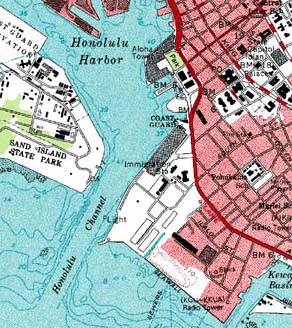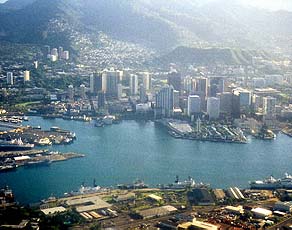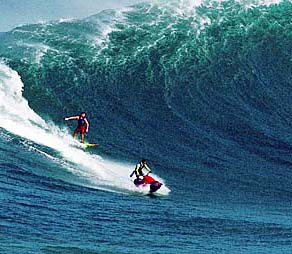 |
 |
 |
|||||||||||||||||||||
|
|
|
|
|
|
|
|
|
||||||||||||||||
|
|
|||||||||||||||||||||||
|
|
|
|
One of Sand Island's beaches.
|
|
"What’s really striking to me about that whole shoreline," explains John Clark, "is that it’s totally artificial. There’s nothing, I believe, left of the original shoreline in that ahupua‘a. If you look at that shoreline, it’s all man-made, it’s all developed. And even Sand Island is a man-made island too. I’ve thought it through, that if you go from the Pearl Harbor entrance channel, all the way to the foot of Diamond Head, it’s almost entirely man-made, artificial shoreline, all the way through. I don’t think there’s anything original left in there."
|
||
|
|
||
|
"On the Diamond Head side of the entrance channel going into the harbor, that’s all landfilled too, Piers One and Two. And we call it Fort Armstrong. Even though its all just commercial wharfage right now, we still call that area Fort Armstrong, and apparently, there was a military fort there, and there were quarters, there were homes that were along the oceanfront there. "I ran into this old surfer who told me he remembered surfing in front of Fort Armstrong, and you’d actually ride right into where the old homes were there on the beach. This would have been prior to the landfill that created Point Panic and all the rest of that area."
|
|
|
"At some point, that reef there ran way back in, it must have run all the way into that Ala Moana area, and the landfills just slowly over the years, crept out until they covered all of the reefs, and covered the surf sites, and we’ve got pretty much what we’ve got now." As enormous sea walls were built and whole areas of shoreline extended out into the sea, the beach areas surrounding Honolulu harbor gradually were overrun by commercial development. But as Sand Island was created (see next page, On the Reef), a new series of beaches and surfing spots came into being.
|
|
|
|
Surfing Sand Island, near "Towers."
|
"There are a number of surf sites between Kalihi Channel all the way over to the main entrance channel. One of the first ones is called 'Towers,' and this is going from East to West. There’s an old observation tower that’s still in the park there, and people surf right in front of it. I think the next spot over is called Regulars, and it’s just because of the regular guys that surf there, that’s one of their regular spots."
|
||
|
|
||
|
"There’s also one spot that’s near the Kalihi channel, we call it Rainbows, and that breaks really big. When there’s a really big South swell, it will actually be a second-reef break out there, and I’ve heard that on the really big south swell, they’re doing tow-ins out there, with jet-skis towing the boards. "You get on a surfboard and you’re being towed behind a jet-ski. It’s like water skiing, but what the jet-ski does is it will circle out behind the surf line, and then he tows the surfer in, and the surfer is stretched out so they’re going parallel, and he tows the surfer into the wave."
|
|
|
|
"So they’re towing into really big waves now, like 50, 60-foot waves that you could never paddle into, but the jet-ski is giving the surfer the speed to get in. So tow-in surfing is actually extreme surfing, an extreme version of the sport that’s being practiced primarily here and in California right now. That’s one of the hot spots out there when it’s big, and guys are actually towing in out there."
Tow-in surfing on Maui. Photograph courtesy of Ocean Promotion. |
|
|
|
|
Areas outside the harbor area remain popular with surfers and body-surfers, but within Honolulu ahupua‘a and the Nu‘uanu area, nothing remains of the old coastline, where once Kamehameha's royal fishpond lay. As the action has shifted to Sand Island, we now turn our attention to the reef.
|
||
|
|
||
| |
| |
|
|

|
| Nu‘uanu Home | Map Library | Site Map | Hawaiian Islands Home | Pacific Worlds Home |
|
|
|||
| Copyright 2003 Pacific Worlds & Associates • Usage Policy • Webmaster |
|||











